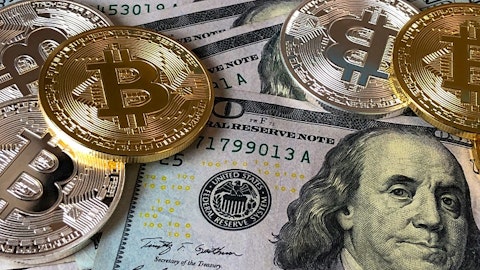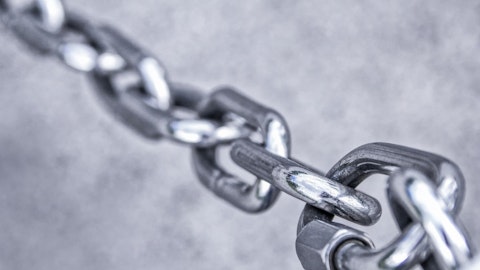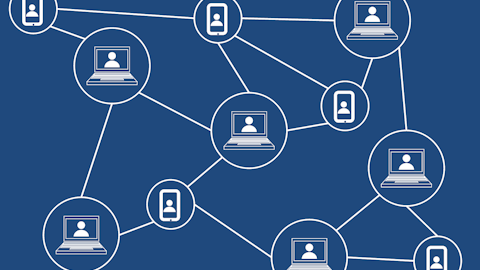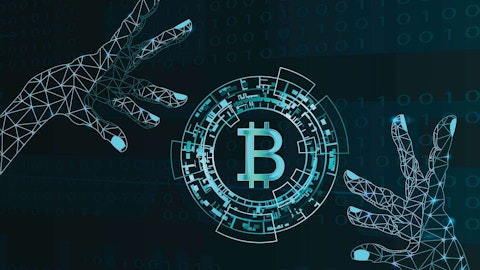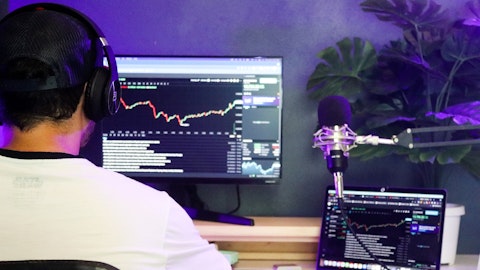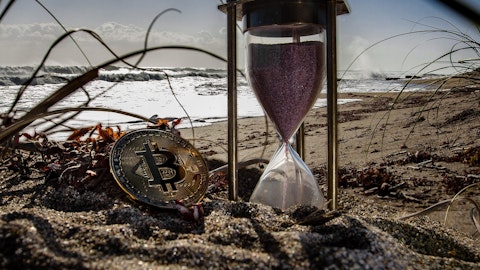Bitfarms Ltd. (NASDAQ:BITF) Q4 2023 Earnings Call Transcript March 7, 2024
Bitfarms Ltd. isn’t one of the 30 most popular stocks among hedge funds at the end of the third quarter (see the details here).
Operator: Good morning and welcome to the Bitfarms Fourth Quarter and Full Year 2023 Conference Call. All participants will be in listen-only mode. [Operator Instructions] After today’s presentation, there will be an opportunity to ask questions. [Operator Instructions] Please note this event is being recorded. I would now like to turn the conference over to Tracy Krumme, Senior Vice President, Head of Investor Relations at Bitfarms. Please go ahead.
Tracy Krumme: Thank you. Good morning everyone, and welcome to Bitfarms Fourth Quarter and Year End 2023 Conference Call. With me on the call today is Geoff Morphy, President and Chief Executive Officer; Jeff Lucas, Chief Financial Officer; and Ben Gagnon, Chief Mining Officer. Before we begin, please note that this call is being webcast with an accompanying presentation. Today’s press release and our presentation can be accessed at our website, bitfarms.com, under the Investor section. Turning to Slide 2, I’ll remind everyone that certain forward-looking statements will be made during the call and that future results could differ from those implied in the statement. The forward-looking information is based on certain assumptions and is subject to risks and uncertainties, and I invite you to also consult Bitfarms’ MD&A for a complete list of those.
Please note that reference will be made to certain measures not recognized under IFRS, and therefore, may not be comparable to similar measures presented by other companies. We invite listeners to refer to today’s press release and our MD&A for definitions of the aforementioned non-IFRS measures and their reconciliations to IFRS measures. Please note that all financial references are denominated in US dollars unless otherwise noted. Turning to Slide 3, it is now my pleasure to turn the call over to Geoff Morphy. Geoff, please go ahead.
Geoff Morphy: Thank you, Tracy, and thank you everyone for joining us today. I am happy to present and discuss with you our Q4 and full year results at such an exciting time in the industry. Multiple converging catalysts are leading to a very bullish sentiment which is sending the Bitcoin price soaring and the market cap of Bitcoin to over $1.3 trillion. The favorable industry tailwinds include, an improving regulatory and macro backdrop, the recent Bitcoin ETF approvals by the SEC, which are leading to rapid retail and institutional adoption, the upcoming halving, which Ben will speak to more in a minute, the positive impact of Bitcoin supply constraints with current daily demand exceeding five to 10 times the daily supply of newly mined coins, and there’s prospect of a lower global interest rate environment which has historically been very favorable to the Bitcoin sector.
Over the last two months, these catalysts have caused a surge in investment interest and investment in publicly traded Bitcoin miners and Bitcoin ETFs. The ETFs have charted unprecedented growth with net inflows exceeding $8 billion. This is not just an anomaly, but a paradigm shift for the industry. Partially as a result of this insatiable demand, earlier this week, Bitcoin achieved a new all-time high price, which is exceptional as this is the first time Bitcoin has attained a new all-time high, leading into a halving. With this demand supply backdrop, 2024 looks to be a banner year for Bitfarms. Turning to Slide 4, I want to start off today’s call with a quick reminder of what Bitcoin is? Why we mine it? And how Bitfarms does it better? Bitcoin is a simple idea, flawlessly executed in code and organically adopted by people around the world at massive scale.
This powerful technology is empowering individuals, entrepreneurs, corporations and even countries and governments to participate in the world’s most open, fair and secure financial system on the planet. As shown in the chart on the left, Bitcoin’s ongoing adoption and organic growth has made it the best performing financial asset of last year and over the last decade, outperforming the S&P 500, NASDAQ 100, MSCI World Index, and Gold. In our opinion, and according to others, Bitcoin is the hardest monetary asset on the planet. Bitfarms is a vertically integrated global Bitcoin mining company that provides investors with high-quality exposure to Bitcoin. Through our publicly traded shares, we are democratizing and making available to investors exposure to some of the world’s best-built, best-operated and lowest cost Bitcoin mining operations and the operating cash flows they generate.
What makes us a leveraged investment play is that every single day since Bitfarms was founded in 2017, we have produced Bitcoin at materially lower cost than what people, institutions and ETFs can purchase it for in the open market. We have earned over 24,000 Bitcoins since inception. I am thrilled to report that in 2023, Bitfarms was the best performing stock on the Toronto Stock Exchange and the eight best performing stock on NASDAQ. A moment ago, I commented that our shares represent a high beta exposure to Bitcoin. As the chart on the right illustrates, in 2023, Bitfarms outperformed Bitcoin by 286% and outperformed the mining industry represented by the Valkyrie Bitcoin Miners ETF by 95%. Bitfarms’ annual share price return of 592% compares to Bitcoin’s annual price appreciation of 155%, which is a beta of approximately three times.
So how did we outperform Bitcoin in 2023? Let’s turn to Slide 5. In 2023, we acted with strong discipline to dramatically transform our balance sheet by growing the company’s hashrate 44%, improving our energy efficiency by 12.5%, thereby reducing our operating cost per terahash, paying down 85% of our debt, increasing our Bitcoin in treasury by 99%, ending the year with $118 million in liquidity, and in November, announcing our transformative fleet upgrade with a contract to purchase upto 63,888 Bitmain T21 miners. These powerful new miners, combined with our new farms under development, are a game changer and put Bitfarms on track to triple our hashrate to 21x hash by year-end 2024 and improve energy efficiency up to 34% to 23 watts per terahash.
Not only does this represent the greatest growth in our six year history, but importantly, our integrated strategic growth plan will drive what we believe will be the biggest relative improvement in energy efficiency in our industry this year. Turning to Slide 6. I would like to elaborate on the impact of our transformative and accretive fleet upgrade program while speaking to our financial discipline and cost focused approach. This month, in Quebec, we will begin to upgrade our fleet, starting with a replacement of approximately 11,000 M31S, M31S+ miners with the first batch of new T21 miners. As a testimonial to our highly efficient operating structure, it is important to note that while these M31S miners are our least efficient and oldest miners, they were purchased around the time of the last halving in 2020, they are still profitable due to our low cost energy and high operating efficiencies.
During these four years, these group of miners have paid for themselves over five times, demonstrating solid ROI returns. On a unit basis, upgrading the M31S to the new T21 miners will deliver a two times improvement in energy efficiency, driving a 50% reduction in our operating cost per terahash. They will also generate a nearly threefold increase in hashrate and mining revenue. All other things remaining constant, the relative improvements from upgrading these M31S miners will more than offset the impact of the upcoming halving on a per unit basis. Turning to Slide 7. Approximately 68% of our T21s on order will be installed in our existing farms with the lion share going to our Quebec farms. By utilizing our existing infrastructure, the upgrade is effectively a plug-and-play operation, significantly reducing CapEx requirements, risks and complexity.
This low risk and low cost growth strategy provides immediate and tangible benefits to Bitfarms and our investors. With the first miners set to be upgraded this month, we are pleased to report that our transformative fleet upgrade is well underway on time and on budget. Turning to Slide 8. I’ll touch upon our progress in Paraguay, where most of our new site development is happening and where we will plan to deploy over 26,000 new miners this year. In Paraguay, we have two new farms under development and on track for energization this year. The first miners at our Paso Pe facility are scheduled to go online this month, with more miners coming online in April. Paraguay is an important area of growth for us. Our two farms under development will generate many value-added corporate benefits including, favorable fixed power contracts at $0.039 per kilowatt hour before that; power contracts with ANDE that are not subject to inflation, no requirements for power curtailment providing up to 100% uptime, 100% renewable energy, fast development, construction and deployment times, exceptionally low cost for construction and skilled labor, and lastly, first mover advantage, securing Bitfarms with a meaningful amount of electricity allocated to the cryptocurrency sector, putting us on track to be the largest miner in Paraguay by year-end.
My recent visit reinforced the merits of our decision to invest further in this country. There is abundant and low priced hydropower, a skilled labor pool, supportive cryptocurrency and Bitcoin mining from the public, and most importantly from the primary electricity utility ANDE. ANDE understands how Bitcoin mining functions as a digital electricity line for exporting their excess hydropower to a global marketplace. By signing power contracts with Bitfarms, they are able to monetize and make better use of their existing infrastructure assets. Additionally, they are able to use revenues from Bitcoin miners to finance the rebuilding and expansion of a significant portion of their domestic power infrastructure, which will bring benefits for generations to come and aligns the interests of Bitfarms, ANDE, and Paraguay.
Turning to Slide 9. With minor upgrades underway and the near completion of the initial phase of development at Paso Pe, we are on track and on schedule to deliver 12 exahash by the end of June 2024. Importantly, with Bitcoin price and spot miner prices rising, the 28,000 miner option that we purchased in November is in the money. Exercising this option is a key element towards achieving 17 exahash per second and through this exercise, we plan to take delivery of T21 miners in the third and fourth quarters of this year in line with the construction schedule at Yguazu. While these carefully constructed plans increase our hashrate to 17 exahash per second, we are targeting more than a threefold growth this year to 21 exahash per second. Should market conditions continue to be favorable, we are actively considering additional farm expansions, new developments, acquisitions, and further minor redeployments to achieve this T21 exahash target by the end of 2024.
With numerous actionable opportunities in our pipeline, we are well prepared to seize upon accretive growth opportunities to fill the remaining four exahash this year. Turning to Slide 10. Let’s take a look at our pro forma portfolio based on the plans that I just discussed. After having successfully deployed 63,888 T21 miners through the transformative fleet upgrade plan and the new farm developments at Paso Pe and Yguazu, we will have completely rebalanced our portfolio both geographically and economically. The expected result is, one, higher operating efficiencies with 79% of our miners operating at 22 watts per terahash and no miners operating above 30 watts per terahash, two, a competitive blend of low cost electricity with high uptime, three, achieving greater geo-diversification with no single country contributing more than 50% of our hashrate and revenue, and four, benefit from predominantly stable hydro power rates, which represent about 85% of our portfolio.
If you take away nothing else from this update, our transformative fleet upgrade is unique both in terms of its scope and its ability to drive meaningful improvements across three key performance indicators, hashrate, energy efficiency, and our direct cost of mine, also known as hash cost. These improvements will take place across all existing farms and farms under construction, ensuring we are ready for the halving and the widely anticipated subsequent bill market. I will now turn the call over to Ben Gagnon, our Chief Mining Officer, to talk about our operating and financial metrics and the various assumptions post halving.
Ben Gagnon: Thanks, Geoff. I’m really happy to be here with all of you today. While this will be my third halving event and the company’s second, for many investors listening in on today’s call, it is likely going to be their first. Accordingly, I think it’s important to spend a few minutes discussing the halving, mining economics and how we think about them. Put simply, halving events as originally envisioned by Bitcoin’s creator and how they have functioned historically are catalysts for creating greater economic value. On the mining side, the 50% reduction in the block reward results in fewer Bitcoins mined, which ceteris paribus incentivizes miners to cut costs. Concurrently, this also means that the daily supply of new Bitcoins that would otherwise be liquidated to pay operating expenses is also cut in half, restricting supply relative to demand and in turn driving prices higher.
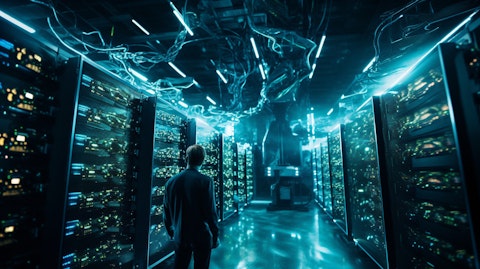
Turning to Slide 12. Historically, each halving epoch follows a similar pattern. One if Bitcoin prices rising faster, the network hashrate can grow in the three to 18 months following a halving, resulting in quickly expanding mining revenue and margins, incentivizing further network growth. Being on the right side of the cycle is crucial for miners to optimize returns and is a key part of our 2024 growth strategy. Despite each cycle producing 50% fewer Bitcoins in revenue than the cycle before it due to rising BTC prices, the economic value of all mining revenue in dollar terms increases dramatically with every halving epoch, resulting in a materially larger industry with more economic activity despite the reduction in BTC terms. Notably, this cycle is marked by three very unique features not seen in previous halvings, the China mining ban in 2021, the emergence of ETFs in January, and the fact that Bitcoin has just hit a new all-time high leading into the halving.
This has never happened before. And with only 450 new Bitcoins expected to be mined per day after the halving, relative to current ETF demand of up to 10,000 Bitcoins a day, it may mean that this next cycle will be unprecedented in terms of its scale. But this is all revenue, and outside of hedging activities, miners have very limited control over revenue. However, we do have full control over our costs, which is why at Bitfarms we take a hashcost first approach to mining. Turning to Slide 13. Energy efficiency is meaningless without also considering electricity costs. That’s why we look at the blended figure hashcost. Calculating hashcost is easy and can be done by simply multiplying energy efficiency with energy price over 24 hours. This will calculate the direct energy cost to operate per unit of compute per day in dollar terms.
As we execute on our upgrade and deployment plan throughout 2024, we expect to improve efficiency 11% from 35 watts per terahash today to 31 watts per terahash by the end of Q1, 29% to 25 watts per terahash by the end of Q2 and 34% to 23 watts per terahash by year-end, driving our hashcost down by similar amounts. Importantly, as Geoff mentioned earlier, we believe these will be the most significant improvements across energy efficiency and hashcost in our industry this year. When comparing that to the most efficient miner on the market, an S21, you can see that our anticipated hashcost will be lower than an S21 operating at $0.06 by the end of Q2 and virtually on par with an S21 operating at $0.05 by year-end, making our hashcosts highly competitive.
When compared to the sensitivity table for hashprice post halving, it is hard to imagine a scenario where our hashcost would operate at a loss. On the contrary, it is very easy to see how our low hashcost relative to hashprice scenarios, positions us to capture the upside of rising Bitcoin prices with quickly expanding mining margins. In summary, the upcoming halving is not something to be afraid of. Our growth plan in 2024 is positioned to make us a leader in low cost production, that at every stage in the deployment plan results in anticipated direct costs to produce a Bitcoin well below current prices, and with a relative growth that is anticipated to outpace the network, rapidly increasing our market share and revenues, all else remaining constant.
With that, I will now hand the call over to Jeff Lucas for the financial review.
Jeffrey Lucas: Thank you, Ben. This is indeed one of the most exciting times in our company’s history as we aggressively pursue our growth plans and make great strides toward 12 exahash per second in the second quarter and our 21 exahash per second target by year-end, more than a tripling of our hash rate. Turning now to Slide 15. Fourth quarter total revenue was $46 million, up 34% over the third quarter and up 71% over the prior year. The quarter-over-quarter comparison reflects 30% higher average Bitcoin price and 5% more Bitcoin earned during the quarter. In the fourth quarter, we earned 1,236 Bitcoin compared to 1,172 in the third quarter. Our hash rate, which does not yet include the impact of our upgrade program, was 6.5% higher sequentially offsetting an increase in average network difficulty of 9%, excuse me, 19% over the third quarter 2023.
Fourth quarter gross mining profit was $23 million or 52% of mining revenue compared to $13 million or 38% of mining revenue in the third quarter. The gross mining profit reflects investment in advance of our growth to 21 exahash per second and other costs reflective of a larger product production operation as well as non-recurring expenses. G&A expenses for the quarter was $13.4 million in comparison to $8.4 million in the third quarter. This includes $4 million of non-cash compensation versus $2 million in the previous quarter. The increase also includes higher incentive compensation payments associated with the achievement of annual performance targets, non-capitalizable professional services that are associated with corporate development to advance our growth initiatives for the second half of 2024 and 2025, and other recurring and non-recurring expenses.
For the fourth quarter, our operating loss was $13 million, including non-cash depreciation expense of $22 million in comparison to a third quarter operating loss of $19 million, also including depreciation expense of $22 million. Our net loss for the fourth quarter was $57 million or $0.19 per basic and fully diluted share compared to our net loss for the third quarter of $17 million or $0.06 per basic and fully diluted share. Included in net loss are net financial expenses of $45 million that includes a $38 million non-cash charge for the re-evaluation of financial liability for warrants issued in earlier financings. For a background about these warrants, during the preparation of our annual financial statements, we reassessed the application of IFRS Accounting Standards when the accounting of private placement financing is closed in the first six months of 2021, almost three years ago.
In consultation with our corporate counsel and accountants, it was determined that the warrants associated with the financings should be treated as a financial liability rather than as equity. Accordingly, the financial statements for 2022 were restated to reflect as accounting. It’s important to bear in mind that these are non-cash adjustments and do not have any impact on our reported adjusted EBITDA. More information and details can be found in our 2023 financial statements in MD&A, which were filed today. Turning our attention now to per Bitcoin production cost and profitability. In the fourth quarter, Bitfarms’ direct cost of production per Bitcoin, which is the all-in electricity cost to mine Bitcoin, was $16,200, down from the $16,900 per Bitcoin in the third quarter of 2023.
The approximate 4% lower cost per Bitcoin primarily reflects a reduction in the overall cost of electricity from $0.045 per kilowatt hour to $0.042 per kilowatt hour. This in turn was driven by a six-month contract with Argentina’s power producer entered into in November that lowered our electricity cost to $0.021 per kilowatt hour, the lowest in our network. This gave Argentina a direct mining cost of less than $7,700 per Bitcoin. With Argentina representing about 22% of our overall Bitcoin production, the benefit to our corporate electricity rate and the direct cost of production will be even greater in the first quarter of 2024. As we’ll have led, we’ll have had the lower rate in effect for the full quarter. Our direct cost in February of 2022 includes a 15% value added tax on Canadian energy costs as a result of legislation enacted last year.
We firmly believe that we are exempt from this incremental tax and are pursuing a revenue ruling with the Canadian and Quebec tax authorities to formalize our exempt status. With Canada representing about two-thirds of our productive capacity, our corporate electricity rate during the quarter without this tax would have been $0.037 per kilowatt hour in comparison to our reported rate of $0.042 per kilowatt hour, and our direct cost of BTC would have been approximately $14,600, $1,600 lower than that we reported. Now on to adjusted EBITDA on Slide 16. Adjusted EBITDA for the fourth quarter effectively doubled over the third quarter to $14 million. We’re at 30% adjusted EBITDA margin in comparison to 9% in the previous quarter. The adjusted EBITDA equates to cash profitability per Bitcoin in the fourth quarter of $11,200, more than double the $5,400 profitability per Bitcoin in the third quarter.
I’d like now to take a minute here to discuss how our adjusted EBITDA reporting is different than that of our peers. As a Canadian company, we follow International Financial Reporting Standards, otherwise known as IFRS. Under IFRS, we do not mark-to-market our Bitcoin holdings, and accordingly, we do not reflect the unrealized gains and losses from our Bitcoin holdings in our income statement and our profitability. Similarly, we do not include these unrealized gains and losses in our adjusted EBITDA. Adjusted EBITDA for us is purely and consistently a measure of the cash profitability of our operations and does not reflect the change in value of our assets and liabilities. It’s a very straightforward and transparent calculation based simply on our cash profit of $11,200 for each of the 1,236 Bitcoin earned, plus roughly $200,000 profits generated at our Volta subsidiary.
That’s it. It is that straightforward. We believe, by the way, that the exclusion of balance sheet changes in our adjusted EBITDA, including a Bitcoin treasury, is a truer measure of the financial performance and the cash generating capability of our operating activities. Turning now to Slide 17 and our liquidity. At December 31st, we held cash of $84 million and Bitcoin valued at $34 million for total liquidity of $118 million. This compares to $47 million of cash and $66 million of liquidity at September 30th. During the fourth quarter of 2023, of the 1,236 Bitcoin earned, we sold 1,135 to generate $42 million of proceeds to fund our operating and debt service requirements. In the fourth quarter of ’23, we raised a total of $52 million in net proceeds from finance activities, $41 million through a private placement completed in November, and an additional $11 million in December from the exercise of warrants related to the private placement.
These funds were specifically earmarked for our growth initiatives and our fleet upgrade plans. During the quarter, we paid down $6 million in debt, leaving us with a remaining balance of $4 million at December 31st. In the current quarter, we paid down the remaining balance and I am very pleased to say, in February, we met our stated target of having no debt on our balance sheet in advance of the halving. Lastly, I want to speak of the accretive nature of our mining upgrade program. The 36,000 minor purchase we announced in November represents a very accretive application of our invested capital. For an incremental capital deployment of about $100 million, we plan to increase our hash rate from 6.5 exahash per second to 12 exahash per second.
This represents a marginal cost, about $18,000 per petahash. I’ll note that a commonly used valuation metric for public miners is enterprise value per petahash. While this metric can vary among miners, the average for our sector overall is about $66,000 per petahash. By extension of this industry metric, we are redeploying or we are deploying about $100 million of capital to create $360 million of incremental shareholder value. Looking ahead, we expect to achieve a similar return on our investor capital with our purchase option for 28,000 additional T21 miners. With that, I’ll now hand the call over to Geoff for concluding remarks.
Geoff Morphy: Thank you, Jeff. Let’s turn to Slide 18. In summary, Bitfarms is a prominent player in the Bitcoin mining sector, offering investors high-quality leverage exposure to Bitcoin by our advanced operational capabilities and mining infrastructure. With an industry-leading yield per exahash, Bitfarms distinguishes itself through exceptional margin performance, demonstrating operational efficiency and profitability in a highly competitive industry, and we are well prepared to navigate the upcoming Bitcoin halving. This preparation is underpinned by our robust balance sheet and strong liquidity, which are crucial for sustaining growth and capitalizing on new opportunities in this volatile market. Led by a strong leadership team with a proven track record of driving profitable growth, our expertise and strategic vision have been instrumental in our success over the past six years, including a previous halving event.
Furthermore, Bitfarms’ commitment to ESG reflects our dedication to sustainable and responsible mining practices. It’s gratifying that our largest projects now under development will draw power from the Itaipu dam, the third largest hydropower facility in the world. Overall, our strategic positioning, operational excellence and commitment to sustainability position us for continued growth and success in 2024 and beyond. With that, I’ll turn the call over to the operator to begin the question-and-answer session.
See also Jim Cramer Says Do Not Buy These 11 Stocks and 16 Best Russell 2000 Stocks To Buy According To Hedge Funds.
Q&A Session
Follow Bitfarms Ltd.
Follow Bitfarms Ltd.
Operator: We will now begin the question-and-answer session. [Operator Instructions] The first question comes from Bill Papanastasiou with Stifel. Please go ahead.
Bill Papanastasiou: Yeah. Good morning, everyone. Thank you for taking my questions. I just wanted to dial in on the salaries expense line. Obviously, it’s increased this quarter, but from my understanding, a large portion of this headcount is obviously coming from Latin America, where expansion plans are happening in Paraguay. Can you speak to the costs of labor in the region? And how should we be forecasting this expense line item going forward?
Geoff Morphy: Good morning, Bill. Let’s move that over to Jeff Lucas, our CFO, to take that question. Thank you.
Jeffrey Lucas: Sure. So good morning as well, Bill. A couple of comments keep in mind here. Actually, one of the benefits of being in Latin America is that the compensation costs relative to North America are dramatically lower. So we are certainly experiencing and going to expect to get a bit of an increase here as we’re building out our team and our professional staff down there as well. Not overly material, I think going forward here. I think what’s more important is understand that in the quarter that just ended, we actually had about $2.1 million of compensation associated with achieving goals and targets that were set actually in 2023, most of which is realized actually in the fourth quarter here. So I think what’s important here is that we actually showed cash compensation around $5.1 million in the quarter that just ended.
To normalize this going forward, it’d be more like around $3.1 million, reflecting merit increases that we have in place for this year versus in the fourth quarter, and also the build out of our organization overall.
Bill Papanastasiou: Great. Thank you. And then how’s the team kind of positioning? And how’s the decision-making changing, given the spot price appreciation and transaction fees moving higher in the market? How do you forecast incremental market opportunities following the halving at this point?
Geoff Morphy: There’s a few things there. Ben, why don’t you jump in and talk about the transaction fees and sort of how we account for those and how we plan for them?
Ben Gagnon: Sure. I have to take that question. We take a conservative approach when it comes to modeling transaction fees and potential revenue, which is why we take a look at our hashcost first. By positioning ourselves on that lower end of the operating cost curve, we basically make ourselves in a position where irregardless of what happens with mining revenues or transaction fees, we’re going to be in a position that’s going to be profitable for modeling purposes. We look at a hashcost of $0.06 per terahash, and that’s something that we’ve had in place for the halving for about 18 months now in our models. As we are at around $67,000 now, where the halving happen tomorrow, we’d be at roughly $0.056 per terahash. So right about on the money for where we anticipated us to be.
As we’re looking forward, we’re going to continue to evaluate where hash price is, where mining prices are and try and look at opportunities in that framework. But certainly, we’re always open to accretive opportunities for us to increase our footprint and increase our hash rate in cost effective ways.
Geoff Morphy: Bill was that sufficient for your question or was there a little more to it?
Bill Papanastasiou: Yeah, I mean, maybe you can just provide a little bit more color, Geoff, in terms of how you think market opportunities looking at potential M&A in the space following the halving just given the better favorable market outlook.
Geoff Morphy: Happy to do that. Well, I’ve been asked a similar question, I think, quarterly for the last year and a half, and my answer really hasn’t changed. We are excited about continuing to grow Bitfarms. We’re in it for the long term. We have a corporate development team that specializes in looking for organic and inorganic opportunities for us. We have quite a system for evaluating these opportunities. We are out there and looking for good assets, good people, and opportunities to grow, whether that’s in the United States, whether it’s in Canada or whether it’s in Latin America or elsewhere. We believe that finding surplus, low cost electricity, preferably renewable, is the long-term benefit to the company. So if somebody else has developed something that makes sense to us and we can get it at the right price strategically, then we’re happy to layer it in.
And frankly, we’re looking at — we’ve looked at a number of opportunities, but we remain disciplined. We do not want to overpay. There’s probably opportunities like very much so in the United States right now in some of the demand response areas. They are attractive, but it has to fit within our regime. It needs to be at the right cost and it needs to add strategic value. So we continue to look the halving. Everybody says there’s going to be consolidation. We expect there probably will be too. We have our eyes wide open, and this company, this time around, in the four-year epoch, is so much stronger and more able to react to these type of good opportunities than we were four years ago. So this is an exciting time, not just for our growth this year, but for the opportunities that might present themselves.
Bill Papanastasiou: Okay. Great. I appreciate the color. That’s all the questions I have now.
Geoff Morphy: Thanks, Bill.
Operator: The next question comes from Kevin Dede with H.C. Wainwright. Please go ahead.
Kevin Dede: Good morning, gentlemen. Thanks for having me on the call. Appreciate the presentation, Ben, on hashcost. I think it’s only you and Harry that look at things that way. So I appreciate it you peeling the onion back there on that. Geoff, would you mind talking a little about Argentina? I think Mr. Lucas mentioned a $0.021 cost there on a six-month contract. Are you sort of scratching your head and thinking about executing on taking your 54 megawatts to 200 there? And maybe add your perception of what you’ve seen of the government , drastic change in government in Argentina, and how that might lead you one way or the other?
